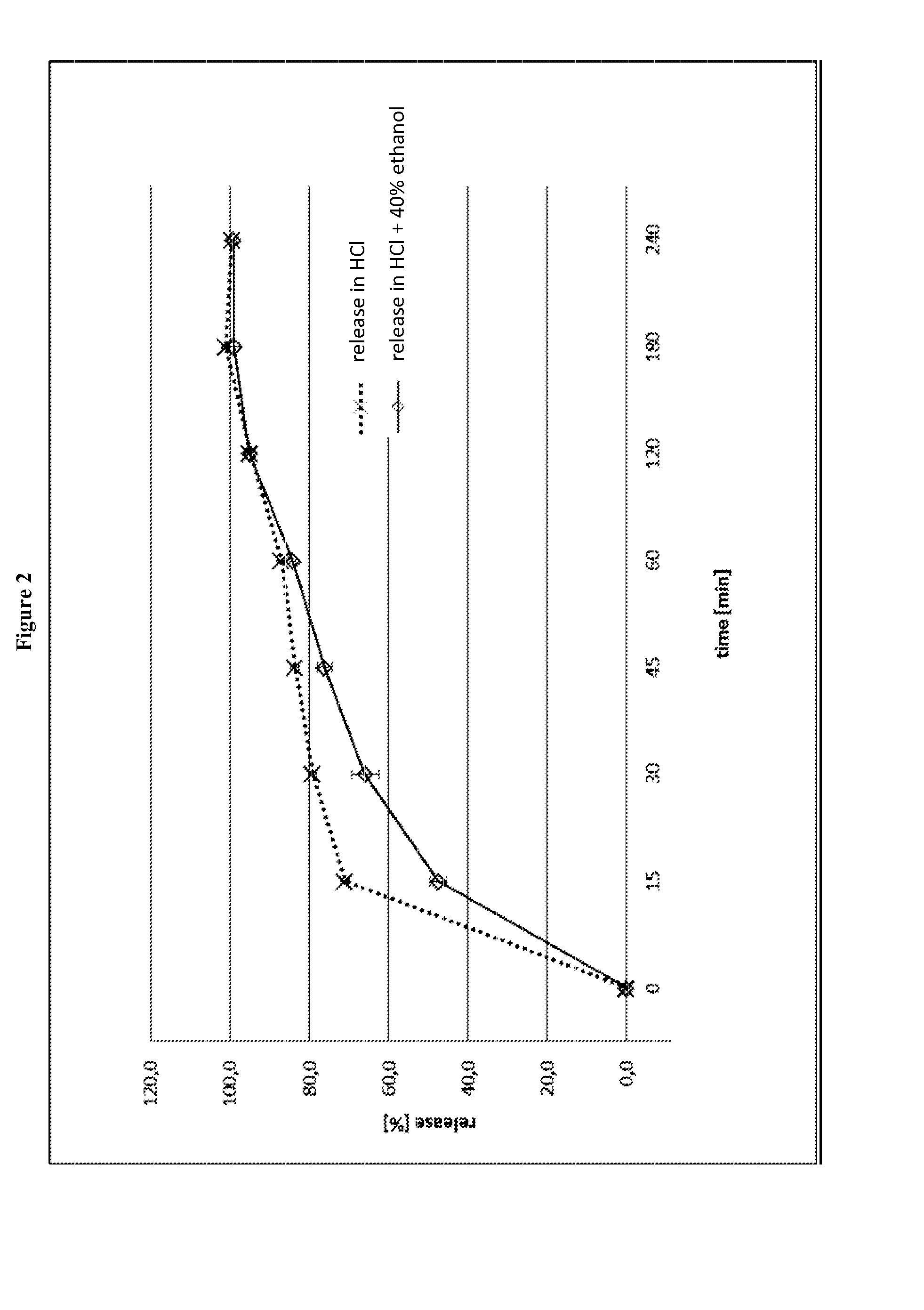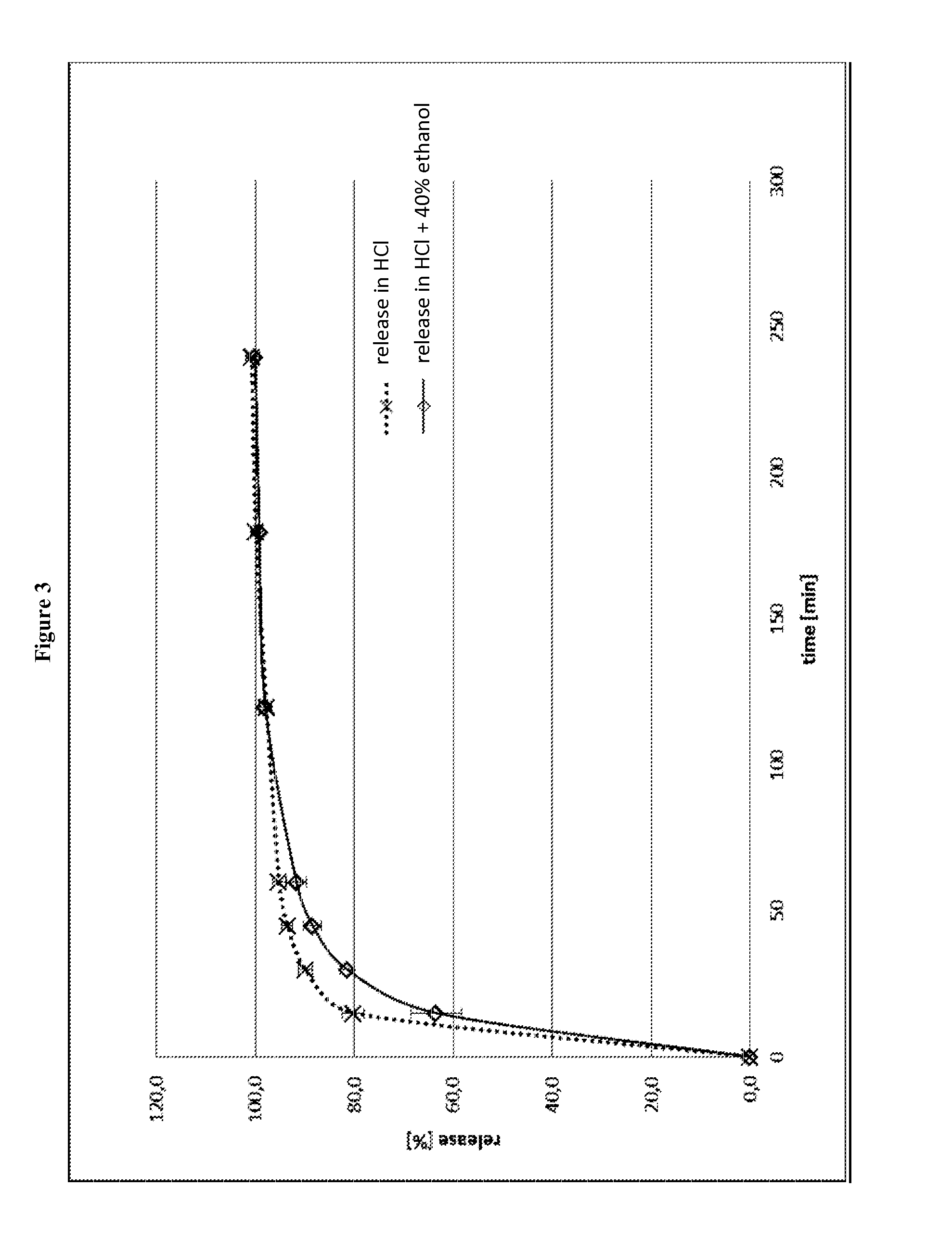Multiparticles safeguarded against ethanolic dose-dumping
a multi-particle, dose-dumping technology, applied in the direction of biocide, plant growth regulator, animal husbandry, etc., can solve the problems of large number of pharmacologically active substances that have a potential for being intentionally or unintentionally abused or misused, inducing dose dumping, and dosage forms containing active ingredients having a high solubility in water usually have a high susceptibility to ethanolic dose dumping. good solubility
- Summary
- Abstract
- Description
- Claims
- Application Information
AI Technical Summary
Benefits of technology
Problems solved by technology
Method used
Image
Examples
example 1
[0329]Capsules having the composition summarized in Table 1 below were prepared according to the general procedure:
TABLE 1m in mg(per capsule)m in wt.-%Tramadol HCl50.010.0Ethylcellulose Ph. Eur.400.080.0(Ethocel Standard 100Premium)Xanthan Gum Type 60250.010.0total500.0100.0relative weight ratio of xanthan gum to ethyl1:8cellulosetotal content of ethyl cellulose and xanthan gum90.0
[0330]FIG. 1 shows the release profile of the capsules in 0.1 N HCl and in a mixture of 0.1 N HCl and 40% ethanol, respectively.
[0331]As can be seen from FIG. 1, the release of the active ingredient is prolonged and is not influenced by the addition of ethanol.
example 2
[0332]Capsules having the composition summarized in Table 2 below were prepared according to the general procedure:
TABLE 2m in mg(per capsule)m in wt.-%Tramadol HCl25.05.0Ethylcellulose Ph. Eur.422.084.4(Ethocel Standard 100Premium)Xanthan Gum Type 60253.010.6total500.0100.0relative weight ratio of xanthan gum to ethyl1:8cellulosetotal content of ethyl cellulose and xanthan gum95.0
[0333]FIG. 2 shows the release profile of the capsules in 0.1 N HCl and in a mixture of 0.1 N HCl and 40% ethanol, respectively. The data are also summarized in Table 10.
[0334]As can be seen from FIG. 2, the release of the active ingredient is slightly prolonged and the addition of ethanol has a retarding influence on the release.
example 3
[0335]Capsules having the composition summarized in Table 3 below were prepared according to the general procedure:
TABLE 3m in mg(per capsule)m in wt.-%Tramadol HCl75.015.0Ethylcellulose Ph. Eur.378.075.6(Ethocel Standard 100Premium)Xanthan Gum Type 60247.09.4total500.0100.0relative weight ratio of xanthan gum to ethyl1:8cellulosetotal content of ethyl cellulose and xanthan gum85.0
[0336]FIG. 3 shows the release profile of the capsules in 0.1 N HCl and in a mixture of 0.1 N HCl and 40% ethanol, respectively. The data are also summarized in Table 10.
[0337]As can be seen from FIG. 3, the release of the active ingredient is not prolonged. However, the addition of ethanol has a retarding influence on the release.
PUM
| Property | Measurement | Unit |
|---|---|---|
| viscosity | aaaaa | aaaaa |
| pH | aaaaa | aaaaa |
| weight | aaaaa | aaaaa |
Abstract
Description
Claims
Application Information
 Login to View More
Login to View More - R&D
- Intellectual Property
- Life Sciences
- Materials
- Tech Scout
- Unparalleled Data Quality
- Higher Quality Content
- 60% Fewer Hallucinations
Browse by: Latest US Patents, China's latest patents, Technical Efficacy Thesaurus, Application Domain, Technology Topic, Popular Technical Reports.
© 2025 PatSnap. All rights reserved.Legal|Privacy policy|Modern Slavery Act Transparency Statement|Sitemap|About US| Contact US: help@patsnap.com



